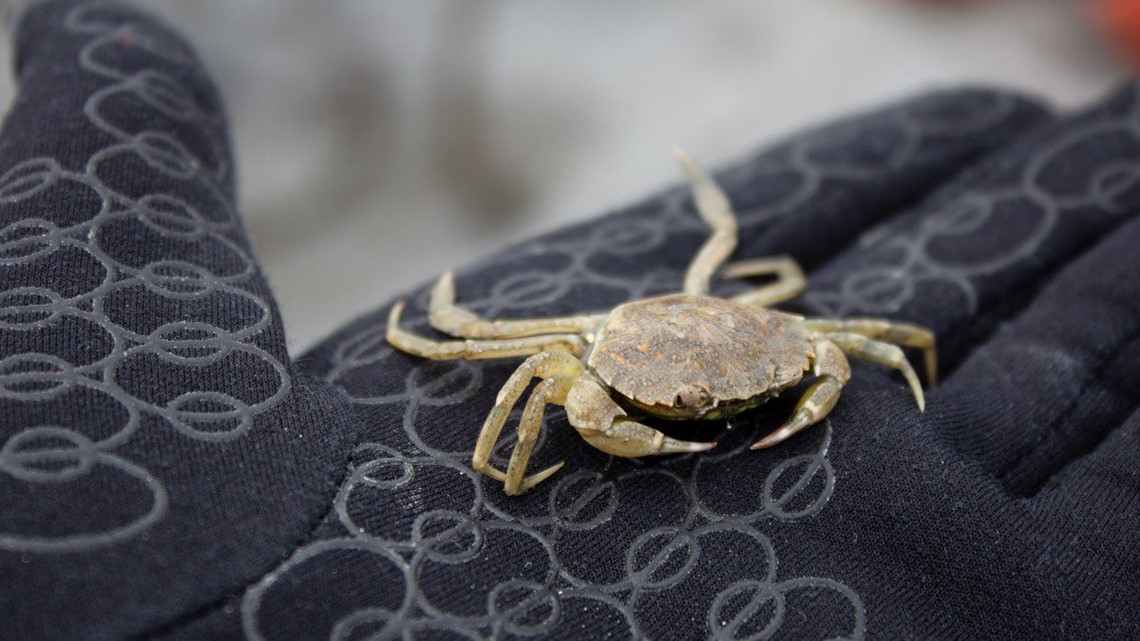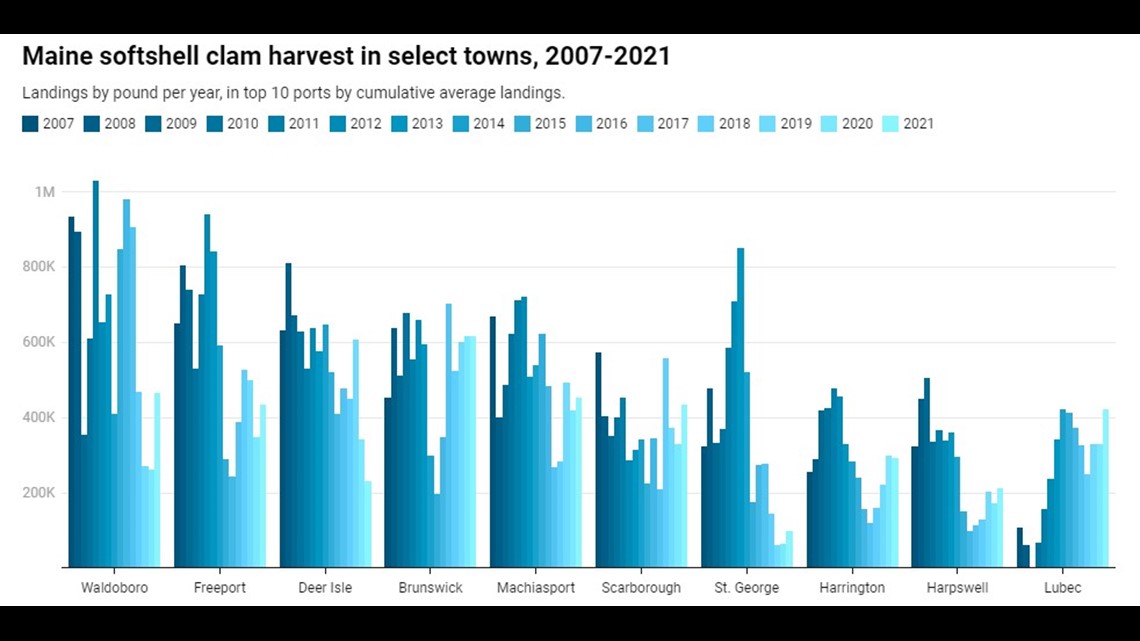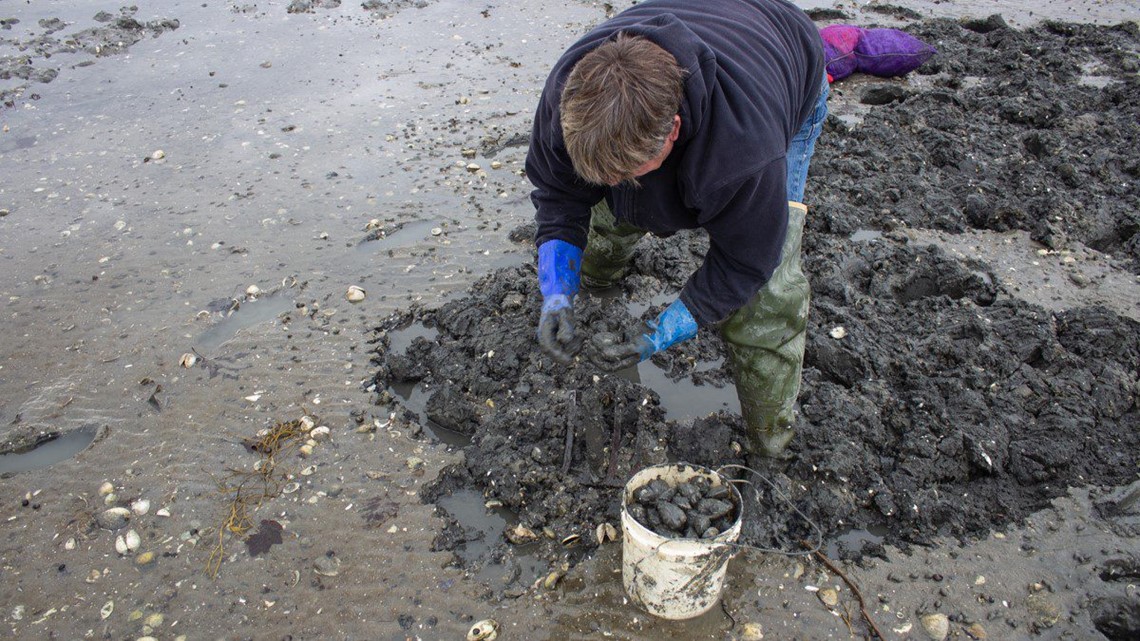FREEPORT, Maine — The Harraseeket River recedes slowly but steadily around Chad Coffin’s metal skiff, until the boat is beached on a partly exposed mudflat. Coffin and his daughter, Bailey Pennell, are already out of the skiff, rakes in hand and rubber boots sinking deep into the gray-brown muck.
They begin to dig — but not for soft-shell clams, also known as steamers, belly clams, or Ipswich clams, a prized Maine commodity that Coffin has harvested here in Freeport for decades. Instead, he and Pennell are scrounging for quahogs, or hard clams. They fetch a lower price, but the part of these flats where any soft-shells might be found is closed to harvest after a recent rain.
“This used to be all clams when I started clamming,” Coffin said. “I would have been able to dig right there, where the mud’s showing already. And now we can’t. There’s nothing there.”
This is becoming a typical struggle for some Maine clammers. Though the soft-shell fishery is typically Maine’s second-most valuable after lobster, statewide landings for the clams are near all-time lows — down from close to 40 million pounds a year in the 1970s to fewer than 10 million pounds a year for most of the past decade.
Coffin and some researchers are confident they know the main reason: green crabs. This invasive species eats clams voraciously, and warming waters are causing the crabs’ population to explode.
“Climate change is just that piece of dynamite that’s been thrown into that room,” said Brian Beal, a professor of ecology and longtime clam researcher with the University of Maine at Machias. “That has just changed everything.”
Beal and Coffin are among the clammers, scientists, and other observers who believe the problems facing the fishery are clear. But the solutions they’re calling for have been slow to gain traction at the state level.
Warming waters drive crabs’ numbers
Coffin turns over chunks of mud on the flats in Freeport with his hand rake, periodically pulling out a quahog and tossing it in a plastic bucket. Almost immediately he also finds something else — a small green crab, sluggish with cold but alive. He tosses it into the skiff. Left out of the water long enough it will die — one down, but many thousands to go.
Coffin and others acknowledge that trying to eradicate green crabs is futile. Gabriela Bradt, a fisheries specialist with the University of New Hampshire Sea Grant who focuses in part on green crabs, blames the decline of very cold winters. Sustained, freezing weather can kill green crabs in intertidal areas, helping to keep the population in check.
“Up until about 15, 20 years ago, we were still getting really long cold winters, you know — like below-zero temperatures for extended days and things like that — and we just don’t get them anymore,” Bradt said. “Now we’ve had extended periods of warm winters, and they’re not being eradicated that way. And so that means they’re eating more, they’re reproducing more for longer periods of time, and their numbers are just out of control.”


Bradt wants to see commercial-scale harvesting of green crabs, which were introduced to North America on ships from Europe in the 1800s — but acknowledges this “eat the invasives” effort may be slow to grow and would only “bring them down to hopefully a dull roar.”
Meanwhile, the average winter low temperature in coastal Maine has risen from single digits in the early 1900s to the low 20s in recent years, according to the state climatologist’s office.
This kind of increase is a boon to green crabs. In the 1950s, the Gulf of Maine saw a short, seemingly random spike in temperatures — and with it, a proliferation in green crabs that decimated the clam sector, according to a key 1955 study, which Beal shared.
“We should have known what was going to happen because it had already happened before,” Beal said. “It’s just no one paid attention.”
Losing the next generation
Sara Randall, the associate director of the Downeast Institute, has worked with Beal on myriad studies about soft-shell clams and green crabs — including more than 30 experiments in Freeport alone between 2013 and 2018.
“We found that over 99% of the clams that are settling out of the water column (into a mudflat) are dying before they reach 1 year old,” Randall said. “The 1-year-old part is important because that means they’re not reaching harvestable size.”
It can take at least two years for these vanishingly tiny juvenile clams to grow into adults and reach the minimum harvestable size of 2 inches across. Smaller clams don’t bury themselves as deep into the mudflats, leaving themselves especially vulnerable to predators like crabs.
“Clams start growing and become food,” Coffin said. “That’s what I learned with (Beals’) research — everything is happening before we get a chance to see it.”
The larger clams left for harvest now are mostly concentrated closer to land. This part of the intertidal can be harder for clammers to access, and tends to close to harvest after heavy rains — which are also expected to increase with climate change.


Research suggests that the older clams that can be harvested are not being replaced with a new generation, which could lead to the fishery’s demise.
So some, like Coffin, are proposing a big shift in tactics: Catch the clams while they're babies.
"We need to change the way that we fish for bivalves in Maine," Coffin said. "We need to fish for them when they're in the larval stage because if we don't, they won't be there. We have to fish for them when there's 30 of them on the head of a pin … and then protect them until they're a size that is commercially valuable."
Research on the best ways to do this is ongoing, but Beal said it likely would involve nets or boxes built into the mud where clams could grow safely, relatively protected from green crabs.
In some ways, this approach and its complications resemble aquaculture — the kind that's on the rise in Maine for oysters, mussels, and kelp. But people like Randall shy away from this term, worried it can carry a stigma for clammers who pride themselves on a "wild" catch.
"This is not, like, aquaculture for aquaculture's sake. It is adapting to the changed ecological circumstances that we're in, which is driven by the warming water," Randall said. "I call it active management or adaptive management. … It's all about the question of, how are we going to be able to continue to have this fishery?"
These approaches also come with many new challenges for clammers. There's currently no permit to allow the taking of larval clams, though something similar does exist in the scallop fishery. Clammers could also need leases — and face conflicts with neighbors — to build in the mudflats. Ownership rights in the intertidal are the subject of an ongoing court fight.
Turning point for a graying fleet
Many of the biggest clamming towns are Down East, in rural communities where fishing is a linchpin of local economies. Some towns farther south — such as Freeport and Brunswick — also rank high for clam landings because of their expansive mudflats. An influx of new coastal property owners in these areas has led to new tensions over access to the clam flats.
Clammers also face more universal sustainability concerns. As in many fisheries, the fleet is getting older and faces health problems from the grueling physical nature of their work. Pennell, Coffin's 23-year-old daughter, has decided to work in oyster aquaculture instead of clamming.
"They're easier for me to get, and I like doing oysters more because it's more entertaining, I think," she said as she chucked quahogs into an orange bin on the mud. "Easier on your body."
"They're on top of the mud," Coffin added. And, he said, harder — though not impossible — for green crabs to eat.


Caitlin Gerber, a conservation steward with the Maine Coast Heritage Trust and co-owner of Chebeague Island Oyster Company, said she's seen larger green crabs tear open a plastic bag of oyster seeds — but overall the dead-loss is more manageable than for clams.
To her, the biggest trade-off with an aquaculture approach is cost. Traditional clamming requires little of the investment of, say, buying a lobster boat or starting an oyster farm. But she said more of that so-called "active management" may be the best option as waters continue to warm.
"I think if you want a future living off of the marine world, it's something to consider. … I love having any opportunity to work on the water, be in touch with what's going on under the surface, and aquaculture allows me to do that," Gerber said. "But I would understand anyone that would say, 'Ah, I just want to do it the way I've been doing it until I can't anymore.' "
Debate over size limits
Small studies and experimental programs at the local level have popped up across the state to try and revive clam harvests with aquacultural tools.
The nonprofit Manomet Institute has put out guidance on clam farming and looked for ways to grow the quahog fishery. In Gouldsboro, volunteers are trying to raise Downeast Institute-grown soft-shell clams in protective trays, though infiltrating green crabs have eaten into their success.
But Coffin and others argue that local or voluntary changes aren't enough, and statewide reforms will be necessary to make clamming commercially sustainable.
Besides new permitting schemes for raising clams from wild-caught larvae, changes could include size limit changes to allow the harvest of smaller adults while making larger clams off-limits so they can keep breeding and replenishing the dwindling population.
Right now, clams must be at least 2 inches across to be harvestable, with no required upper size limit. In 2017, the state legislature's Marine Resources Committee killed a bill to lower the minimum to 1.5 inches and set a new maximum. The state Department of Marine Resources testified against the proposal, citing industry concerns about the marketability of smaller clams.
Coffin and DMR officials have come into bitter conflict over issues like this. While digging for quahogs in Freeport, he called DMR "pathetic" and said its scientific approach was based on "myth."
"I think if you're going to manage an animal or a biological resource, that you have to at least apply some of the biology of that animal," Coffin said. "It can't just be all about what a market wants or what, you know, a fisherman wants to do."
Solutions at scale
Melissa White, the newly appointed head of DMR's recently renamed Nearshore Marine Resources Program, declined a phone interview but responded to questions by email.
"The Nearshore Marine Resource Program will be investigating issues affecting Maine’s softshell clam populations including predation, warming ocean waters, and climate change," she said. "Through these investigations, we intend to identify the biggest threats and help municipalities develop plans to address them."
White said the investigations will include monitoring "sentinel sites" where they can study clam recruitment — the fishery term for baby clams joining the harvestable population.
Much of the planned state research will be similar to studies Beal and others have completed in recent years, which he said frustrates him.
White also said DMR would "be happy to engage industry in any conversation about potential data-driven changes to size limits," and noted that external research is in the works.
It could include a "fecundity study" that Beal and Randall will undertake in the next two years. Its goal is to pinpoint what makes clams most successful at reproducing — factors like time of year, tidal height, the clams' size, and geographic location.
Beal said adjusting DMR's size limits for clams on a pilot basis, with a five-year sunset clause, would make sense and could function as useful research by itself.
"If we're actually seeing more clams settling and surviving, well, then, that's the way to do it," he said. "We know we can't keep green crabs at bay — because we've put all the nets out, because there's just not enough time, and people, and money to do that. You can do it on the scale of an acre or two, but you can't do it on the scale of the state of Maine."
On their tiny patch of Freeport's 1,200 acres of intertidal area, Chad Coffin and his daughter are caked in mud and bagging up a modest haul of quahogs as the tide begins to rise again. It's already been another rough season for soft-shells. Coffin fears next year will be even worse.
"This is an incredible amount of resources available, as far as the mudflats go," Coffin said. “It's just there isn't much in them anymore."
This story was originally published by The Maine Monitor, a nonprofit and nonpartisan news organization. To get regular coverage from the Monitor, sign up for a free Monitor newsletter here.

